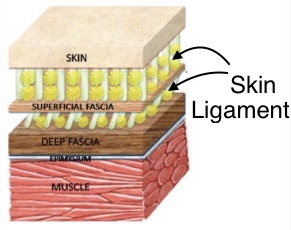by Mitch Hauschildt, MA, ATC, CSCS
As many of you know, I love tweak taping. I teach it in the Rocktape FMT Performance course and use it or a variation of it for the majority of my taping applications with my athletes. It has proved to be a great way to improve range of motion and decrease pain very quickly and efficiently with pretty much no side effects. But, the question I often get is, “how does it really work?”
It can be difficult to wrap your head around how and why this technique works. How can a little bit of tape, combined with some skin drag make such a crazy improvement? In an effort to de-mystify tweak taping, we are going to take a minute and walk through the theory behind it, as it is currently understood. 
When we look at Tweak Taping, we have to understand the layers just under the skin. We have multiple layers of tissue, including our dermis, superficial fascia, deep fascia, muscle and bone. The layers are designed to slide and glide over top of each other. This slide and glide is to be done efficiently and smoothly and within a specific range.
The anatomical structures that limit the range are our skin ligaments. The technical term is the Retinaculum Cuteus Superficialis and the Retinaculum Cuteus Profundus. I’m not concerned that you know the technical terms. I’m more concerned that you know that they exist and what they do.
The role of skin ligaments is to bind layers together, while allowing enough freedom that the layers can slide and glide over top of each other. Another important role of the skin ligaments is to house peripheral nerves. Some skin ligaments are hollow, similar to tubes or straws. These hollow skin ligaments allow small nerves to go from deeper tissue out to the surface of the skin to provide feedback and information to the system overall.
 The problem that arises in many people is that their various layers of tissue can become stuck or offset due to trauma, chronic issues or poor movement patterns. When these layers don’t align properly, the peripheral nerve becomes entrapped, or pinched, as it tunnels through the layers. This entrapment will send a “danger” signal to the brain because the nerve is feeling pinched and compromised. Anytime that the brain receives a danger signal, it will limit motion and/or send a pain signal to reduce the threat of future issues.
The problem that arises in many people is that their various layers of tissue can become stuck or offset due to trauma, chronic issues or poor movement patterns. When these layers don’t align properly, the peripheral nerve becomes entrapped, or pinched, as it tunnels through the layers. This entrapment will send a “danger” signal to the brain because the nerve is feeling pinched and compromised. Anytime that the brain receives a danger signal, it will limit motion and/or send a pain signal to reduce the threat of future issues.
What tweak taping does is to use directional skin drag to realign the tissue, which easily and quickly reduces the threat to the brain and improving movement. This happens through a trial and error technique to locate specific areas of the skin that are restricted. Every person is going to be different and the location and direction of their restrictions may change over time.
The skin drag should happen manually with our fingers and not by stretching the tape. The tape is simply there to hold the tissue in place. Once the tape is applied, the patient needs to move. They need to explore their new range of motion with properly aligned tissue in an effort to keep lock it in and keep the brain from feeling threatened. Once we understand the direction and location of the skin drag, manual skin drags can be utilized as part of our treatment as well. Take the concept of run with it.
For more information on a hip tweak taping application, check out my post here.


Leave a Reply